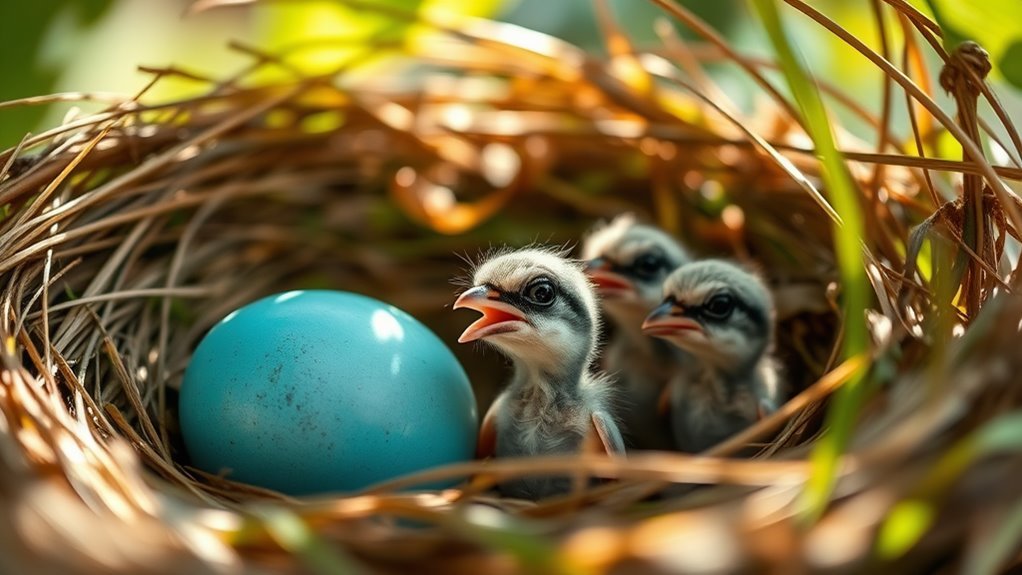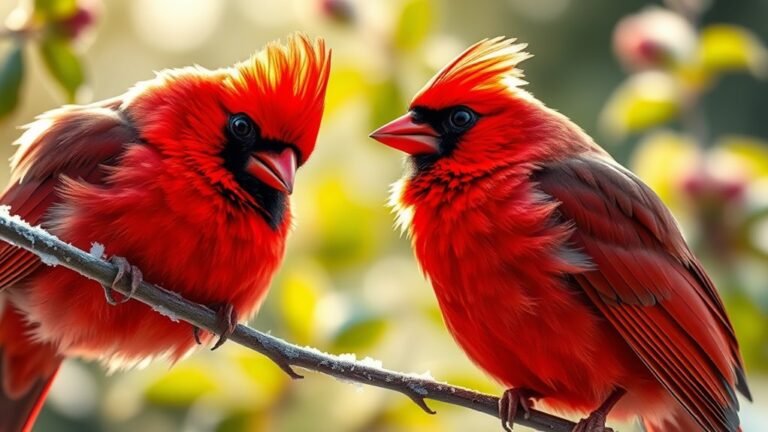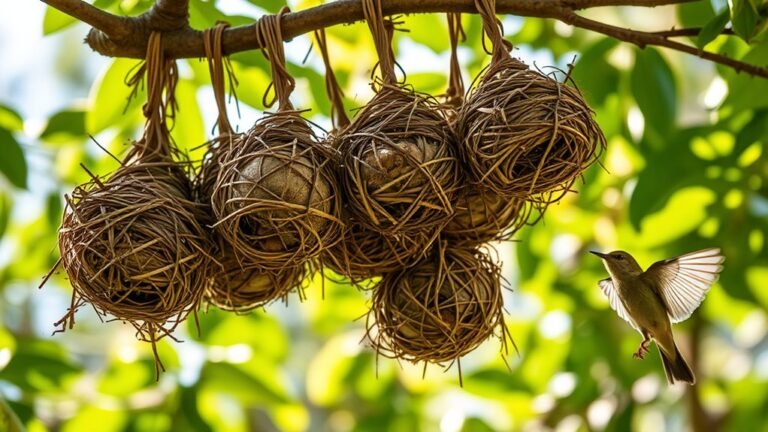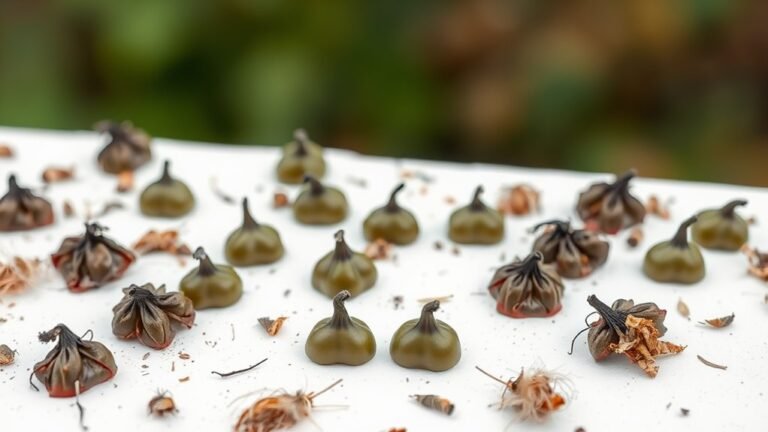Baby Bluebird Development: From Egg to Flight
When you watch baby bluebirds, you see an interesting life cycle. The journey starts when the eggs are laid. Each stage of development plays a key role in survival. As the baby birds grow from hatchlings to fledglings, they show instinctive behaviors and rely on their parents for care. However, as they get ready to fly, they face new challenges in the wild. What awaits them after their first flight into the sky?
Key Takeaways
Bluebirds start nesting in spring. They gather materials like grass and feathers to build a safe space for their eggs. The eggs develop inside hard shells. When the chicks are ready, they use their beaks to break out of the shells.
After hatching, the nestlings depend on their parents for food. They instinctively open their beaks wide to signal hunger. As they grow, fledglings practice flapping their wings in preparation for their first flight. Their parents encourage them with soft calls.
Young bluebirds encounter challenges as they grow. They must avoid predators and compete with their siblings for food. These experiences help them develop and gain independence.
The Nesting Process: Where It All Begins

As spring arrives and temperatures rise, bluebirds start their nesting process. They look for materials to build their nests, choosing items like grass, twigs, and sometimes feathers. Each piece is selected carefully to ensure the nest is warm and safe.
Bluebirds prefer to build their nests on tree branches or ledges, away from predators and disturbances. You can see them in parks or gardens, places full of life.
Watching them build their nests shows their dedication to creating a safe space for their young. This process highlights the beauty of nature and invites you to feel connected to their world.
The Miracle of Hatching: Breaking Free From the Egg
After the bluebird lays its eggs, the wait begins as the eggs grow and prepare to hatch. The hard shell protects the developing chicks while allowing them to breathe.
As days go by, you may see small movements in the eggs, indicating that the chicks are ready to emerge.
The hatching process starts when the chicks use their beaks to break through the shell. This takes effort and energy, showing their strong desire to survive.
Watching this event unfold connects you to the cycle of life. You can appreciate the determination and instinct that guide these young bluebirds as they take their first breaths.
The Early Days: Nestling Development

Once bluebirds hatch, their early days as nestlings are crucial for development. They instinctively open their beaks wide, eagerly waiting for their parents to feed them. Each chirp and movement indicates progress toward important milestones, like feather growth and muscle strength.
As days pass, you can see them start to coordinate their movements and test their wings within the nest. This behavior shows how they respond to warmth and safety, laying the groundwork for future flight.
These formative days strengthen the bond between nestlings and their parents, supporting both survival and a sense of belonging.
Nutrition and Growth: Feeding the Future
Bluebird parents care deeply for their nestlings. Nutrition is vital for the growth and development of the young birds.
As the nestlings grow, their dietary needs change. Parents play a key role by providing a variety of food, such as insects and berries. They feed their young multiple times a day to ensure they receive enough nutrients.
This attentive feeding behavior helps the nestlings grow strong and healthy. Well-fed bluebirds are happier and more resilient.
Each meal contributes to building a solid foundation for their future independence. Soon, these young bluebirds will fly freely in the sky, thanks to the care they received during their early growth stages.
The First Flight: Gaining Independence

As the baby bluebirds prepare for their first flight, you can feel the excitement in the air. Each fledgling flaps its wings, testing their strength. This behavior helps them get ready for independence.
- They sit at the edge of the nest, looking down with caution.
- Parent bluebirds encourage them with gentle calls and short flights nearby.
- The young birds chase each other, practicing their coordination.
- When they take off, it shows their instinct and courage, marking an important step in their growth.
With each attempt, you see their determination and strength, showcasing nature's plan for these young birds to find their freedom.
Challenges and Survival: Navigating the Wild
Fledgling bluebirds face many challenges after leaving the nest. They must quickly learn to avoid predators like hawks and snakes to survive.
Harsh weather can also threaten their lives. Parental guidance is crucial; adult bluebirds teach their young how to find food and shelter.
However, sibling rivalry can create competition for resources, pushing them to establish their place in the family.
As bluebirds grow, they claim their territory, which can lead to fights with neighboring birds. Each challenge shapes their development, highlighting their determination to thrive in a tough environment.
Frequently Asked Questions
How Long Do Baby Bluebirds Stay in the Nest After Hatching?
After baby bluebirds hatch, they stay in the nest for 18 to 21 days. During this time, they grow stronger and learn skills needed for flying. Watching them develop is a fascinating experience. Soon, they will be ready to leave the nest and explore their surroundings.
What Predators Threaten Baby Bluebirds During Their Development?
Baby bluebirds face many threats while they are developing. Cats and raccoons are common predators that can harm them. These animals increase the risk of predation, putting fledglings in danger as they depend on their nests for safety during their early growth. Protecting these nests is crucial for the survival of baby bluebirds.
How Do Bluebirds Communicate With Each Other as Nestlings?
As you watch bluebird nestlings, you will hear their chirping during interactions with siblings. These sounds express their needs and feelings. This communication helps them build connections and work together, which is important for their growth and safety in the nest.
What Environmental Factors Affect Bluebird Development and Survival Rates?
Environmental factors impact bluebird development and survival rates. Habitat quality and food availability are crucial. Healthy nests often exist in ideal habitats. These areas provide enough food sources, supporting growth and nurturing strong fledglings. Strong fledglings are better prepared for life after leaving the nest.
When Do Baby Bluebirds Develop Adult Plumage?
Baby bluebirds begin to show signs of developing adult feathers around 8 to 10 weeks old. At this stage, they have juvenile colors. By four months, they typically acquire their bright, adult plumage. This change is an important part of their growth and development.

Ava is a bird enthusiast and nature lover who has spent countless hours observing and learning about the fascinating world of birds. With a passion for sharing her knowledge and inspiring others to appreciate the beauty of birds, Ava writes about her experiences and insights on avianadmirer.com.







